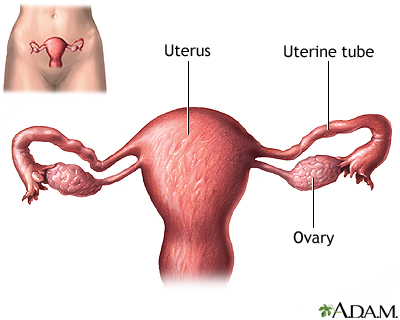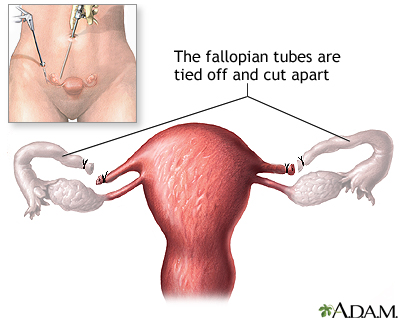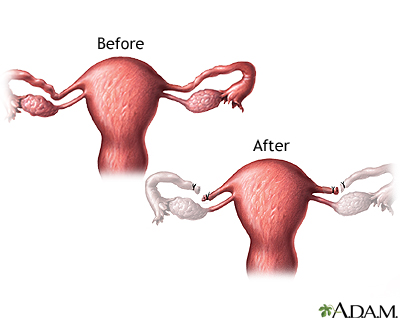Tubal ligation
| Normal anatomy |
The ovaries interact with the uterus through the fallopian tubes. The egg travels from the ovary through the tube to the uterus.
|
| Procedure |
Tubal ligation is surgery to tie the tubes (fallopian tubes) of a woman. This prevents transport of the egg (ovum) to the uterus, causing permanent infertility (sterility). Tubal ligation may be recommended for adult women who wish to prevent future pregnancies (permanent sterilization). Tubal ligation is not recommended as a temporary or reversible procedure.
Tubal ligation occurs in the hospital while the patient is deeply asleep and free of pain (using general anesthesia). A small incision is made in the abdomen, through which a small telescope (laparoscope) is inserted. The tubes (fallopian tubes) are tied off and cut apart. The skin incision is stitched closed. The patient is able to return home within a few hours after the procedure.
Tubal ligation can be performed immediately after childbirth.
|
| Aftercare |
Most women recover with no problems. No tests are required to verify sterility.
Most women are advised to avoid strenuous exercise for several days. Oral pain medications can usually manage the pain. Most women are able to return to work within a few days. Women who have this procedure can resume sexual intercourse as soon they feel ready (usually within a week).
|

|
Review Date:
5/14/2012
Reviewed By:
Harvey Simon, MD, Editor-in-Chief, Associate Professor of Medicine, Harvard Medical School; Physician, Massachusetts General Hospital. |
The information provided herein should not be used during any medical emergency or for the diagnosis or treatment of any medical condition. A licensed medical professional should be consulted for diagnosis and treatment of any and all medical conditions. Links to other sites are provided for information only -- they do not constitute endorsements of those other sites. © 1997-
A.D.A.M., Inc. Any duplication or distribution of the information contained herein is strictly prohibited.





